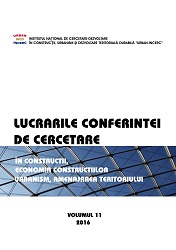Lucrările conferinţei de cercetare în construcţii, economia construcţiilor, urbanism şi amenajarea teritoriului
Paper proceedings of the research conference on constructions, economy of constructions, architecture, urbanism and territorial development
Contributor(s): Alexandru-Ionuţ Petrişor (Editor), Vasile Meita (Editor)
Subject(s): Politics / Political Sciences, Social Sciences, Economy, Fine Arts / Performing Arts, Architecture, Geography, Regional studies, Human Geography, Regional Geography, Environmental Geography, Governance, Sociology, Socio-Economic Research
ISSN: 2393-3208
Published by: INCD URBAN-INCERC
Keywords: urban planning; architecture; civil engineering
Summary/Abstract: Includes full papers presented in the esearch conference on constructions, economy of constructions, architecture, urbanism and territorial development, 11th edition. Individual abstracts available for each article.
- Page Count: 46
- Publication Year: 2016
- Language: English, Romanian, French
Creşterea rezilienţei prin formarea unei "culturi a siguranţei" la nivelul comunităţilor locale
Creşterea rezilienţei prin formarea unei "culturi a siguranţei" la nivelul comunităţilor locale
(Increasing resilience by forming a "culture of safety" for the local communities)
- Author(s):Alina Chicoş, Alina HUZUI-STOICULESCU, Georgiana Toth
- Language:Romanian
- Subject(s):Human Geography, Regional Geography, Environmental Geography, Applied Geography, Sociology, Socio-Economic Research
- Page Range:7-16
- No. of Pages:10
- Keywords:resilience; risk-prone areas; social actors; culture of safety
- Summary/Abstract:The concept of resilience is useful for understanding and analyzing the contemporary urban systems, to define new approaches and to establish new urban planning principles. From this perspective, the paper highlights the issue of territorial development of human settlements in the context of exposure to earthquakes, floods and landslides. Exploring the attitudes of social actors towards prevention policies and protection against certain disasters shows that the partnership between community and institutional structures is the solution for a sustainable development of these risk-prone territories. Consequently, a community-based "culture of safety" is expected to emerge based on an increased involvement of local people in prevention activities.
Rezilienţa infrastructurală şi instituţională - model de evaluare a rezilienţei şi propuneri de minimizare a vulnerabilităţii la alunecări de teren
Rezilienţa infrastructurală şi instituţională - model de evaluare a rezilienţei şi propuneri de minimizare a vulnerabilităţii la alunecări de teren
(Infrastructural and institutional resilience - model for evaluating the resilience and proposals for reducing the vulnerability to landslides)
- Author(s):Constantin CHIFELEA
- Language:Romanian
- Subject(s):Physical Geopgraphy, Human Geography, Regional Geography, Environmental Geography, Applied Geography
- Page Range:17-25
- No. of Pages:9
- Keywords:resilience; critical infrastructure; model; landslides
- Summary/Abstract:The aim of strategies for resilience of critical infrastructure and institutional framework is the continuous functioning of critical infrastructure against all dangers, as this supports local or national defense and security and being the foundation of economy, prosperity and social welfare.
Reducerea consumului de energie cu ajutorul materialelor termoizolante
Reducerea consumului de energie cu ajutorul materialelor termoizolante
(Reducing the energy consumption by thermo-insulating materials)
- Author(s):Carmen Dico, Andreea Hegyi, Nicolae Benche
- Language:Romanian
- Subject(s):Architecture
- Page Range:29-38
- No. of Pages:10
- Keywords:insulation materials; thermal conductivity; thermal transmittance
- Summary/Abstract:The increase of demand for renovation and thermal rehabilitation, together with the EU legislation adoption through which it wants the reduction of energy use, it led the increasing of insulation materials demand and the necesity for continuous innovation in this area. In this paper it presents a synthesis of information regarding the materials and the ways to reduce the energy consumption and achieving the buildings thermal insulation, in the EU countries. Also, it is presented a comparative study of the advantages and disadvantages of using some of the most common insulating materials on the Romanian market (expanded polystyrene, BCA type plate and MULTIPOR type plate). Although it cannot certainly affirm the superiority of a type of material over another, it was identified the trend of innovation through the existing of MULTIPOR type material, developed on the sustainability principles, which tends to combine some advantages of expanded polystyrene with other suitable properties, characteristic on mineral type materials.
Evaluarea performanţei termice a unei soluţii de reabilitare termică cu panouri vidate tip sandwich
Evaluarea performanţei termice a unei soluţii de reabilitare termică cu panouri vidate tip sandwich
(Evaluation of the thermal performance of a thermal rehabilitation solution using "sandwich" vacuum insulation panels)
- Author(s):Adrian-Alexandru Ciobanu, Claudiu Romila
- Language:Romanian
- Subject(s):Architecture
- Page Range:39-46
- No. of Pages:8
- Keywords:vacuum insulation panels; performance evaluation; high performance thermal insulation
- Summary/Abstract:An increasing interest for efficient measures in thermal insulation of construction is manifested in the world due to the common goal expressed by the population to reduce fossil fuel consumption and greenhouse gas emissions (GHG). Vacuum insulation panels are part of high performance thermal insulation, developed and promoted in the last two decades, they are be trying to be insert and used in construction field. The interest for this type of material is due to their higher thermal resistance compared to traditional insulation materials. The study case presented in the paper analyzes the possibility of using vacuum insulation panels as a solution for the thermal rehabilitation of an apartment outer wall, located in Iasi. The rehabilitation solution consisted thermal insulation of the outer walls with vacuum insulation panels which are protected to the front and to the rear face with extruded polystyrene with 2 cm thickness. The evaluation of the thermal performance of the solution applied to the walls was done for the façade of an apartment located at a current level. It was determined the overall thermal resistance (R’) of the opaque facade, the effective thermal conductivity of vacuum insulation panels was considered 0.0085 W/(mK). Also in this study case was determined the overall thermal resistance for the same opaque facade in the version with expanded polystyrene thermal insulation layer, with 10 cm thickness, thus making a comparative study of this two solutions.

